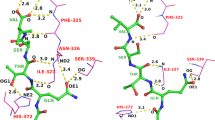Abstract
Fast Fourier transform (FFT) based approaches have been successful in application to modeling of relatively rigid protein–protein complexes. Recently, we have been able to adapt the FFT methodology to treatment of flexible protein–peptide interactions. Here, we report our latest attempt to expand the capabilities of the FFT approach to treatment of flexible protein–ligand interactions in application to the D3R PL-2016-1 challenge. Based on the D3R assessment, our FFT approach in conjunction with Monte Carlo minimization off-grid refinement was among the top performing methods in the challenge. The potential advantage of our method is its ability to globally sample the protein–ligand interaction landscape, which will be explored in further applications.



Similar content being viewed by others
References
Kozakov D, Brenke R, Comeau SR, Vajda S (2006) PIPER: an FFT-based protein docking program with pairwise potentials. Proteins 65:392–406
Gabb HA, Jackson RM, Sternberg MJ (1997) Modelling protein docking using shape complementarity, electrostatics and biochemical information. J Mol Biol 272:106–120
Ritchie DW, Kemp GJ (2000) Protein docking using spherical polar Fourier correlations. Proteins 39:178–194
Tovchigrechko A, Vakser IA (2006) GRAMM-X public web server for protein-protein docking. Nucleic Acids Res 34:W310–W314
Chen R, Li L, Weng Z (2003) ZDOCK: an initial-stage protein-docking algorithm. Proteins 52:80–87
Lensink MF, Velankar S, Wodak SJ (2017) Modeling protein-protein and protein-peptide complexes: CAPRI 6th edition. Proteins 85:359–377
Lensink MF, Wodak SJ (2013) Docking, scoring, and affinity prediction in CAPRI. Proteins 81:2082–2095
Lensink MF, Wodak SJ (2010) Docking and scoring protein interactions: CAPRI 2009. Proteins 78:3073–3084
Porter KA, Xia B, Beglov D, Bohnuud T, Alam N, Schueler-Furman O, Kozakov D (2017) ClusPro PeptiDock: efficient global docking of peptide recognition motifs using FFT. Bioinformatics. doi: 10.1093/bioinformatics/btx216
O’Boyle NM, Vandermeersch T, Flynn CJ, Maguire AR, Hutchison GR (2011) Confab—systematic generation of diverse low-energy conformers. J Cheminform 3:8
Mamonov AB, Moghadasi M, Mirzaei H, Zarbafian S, Grove LE, Bohnuud T, Vakili P, Ch Paschalidis I, Vajda S, Kozakov D (2016) Focused grid-based resampling for protein docking and mapping. J Comput Chem 37:961–970
Moghadasi M, Mirzaei H, Mamonov A, Vakili P, Vajda S, Paschalidis IC, Kozakov D (2015) The impact of side-chain packing on protein docking refinement. J Chem Inf Model 55:872–881
Mirzaei H, Zarbafian S, Villar E, Mottarella S, Beglov D, Vajda S, Paschalidis IC, Vakili P, Kozakov D (2015) Energy minimization on manifolds for docking flexible molecules. J Chem Theory Comput 11:1063–1076
Trott O, Olson AJ (2010) AutoDock Vina: improving the speed and accuracy of docking with a new scoring function, efficient optimization, and multithreading. J Comput Chem 31:455–461
Huggins DJ, Tidor B (2011) Systematic placement of structural water molecules for improved scoring of protein-ligand interactions. Protein Eng Des Sel 24:777–789
Kozakov D, Beglov D, Bohnuud T, Mottarella SE, Xia B, Hall DR, Vajda S (2013) How good is automated protein docking? Proteins 81:2159–2166
Chuang G-Y, Kozakov D, Brenke R, Comeau SR, Vajda S (2008) DARS (Decoys As the Reference State) potentials for protein-protein docking. Biophys J 95:4217–4227
Meiler J, Baker D (2006) ROSETTALIGAND: protein-small molecule docking with full side-chain flexibility. Proteins 65:538–548
Shapovalov MV, Dunbrack RL Jr (2011) A smoothed backbone-dependent rotamer library for proteins derived from adaptive kernel density estimates and regressions. Structure 19:844–858
Grudinin S, Kadukova M, Eisenbarth A, Marillet S, Cazals F (2016) Predicting binding poses and affinities for protein–ligand complexes in the 2015 D3R Grand Challenge using a physical model with a statistical parameter estimation. J Comput Aided Mol Des 30:791–804
Yan C, Grinter SZ, Merideth BR, Ma Z, Zou X (2016) Iterative knowledge-based scoring functions derived from rigid and flexible decoy structures: evaluation with the 2013 and 2014 CSAR benchmarks. J Chem Inf Model 56:1013–1021
Ballester PJ, Schreyer A, Blundell TL (2014) Does a more precise chemical description of protein–ligand complexes lead to more accurate prediction of binding affinity? J Chem Inf Model 54:944–955
Wang C, Zhang Y (2017) Improving scoring-docking-screening powers of protein-ligand scoring functions using random forest. J Comput Chem 38:169–177
Debroise T, Shakhnovich EI, Chéron N (2017) A hybrid knowledge-based and empirical scoring function for protein-ligand interaction: SMoG2016. J Chem Inf Model 57:584–593
Pires DEV, Ascher DB (2016) CSM-lig: a web server for assessing and comparing protein-small molecule affinities. Nucleic Acids Res 44:W557–W561
Cheng T, Li X, Li Y, Liu Z, Wang R (2009) Comparative assessment of scoring functions on a diverse test set. J Chem Inf Model 49:1079–1093
Li Y, Liu Z, Li J, Han L, Liu J, Zhao Z, Wang R (2014) Comparative assessment of scoring functions on an updated benchmark: 1. Compilation of the test set. J Chem Inf Model 54:1700–1716
Acknowledgements
This work was supported by Grants NSF CCF AF 1527292, NIH R43 GM109555, RSF No 14-11-00877.
Author information
Authors and Affiliations
Corresponding authors
Rights and permissions
About this article
Cite this article
Padhorny, D., Hall, D.R., Mirzaei, H. et al. Protein–ligand docking using FFT based sampling: D3R case study. J Comput Aided Mol Des 32, 225–230 (2018). https://doi.org/10.1007/s10822-017-0069-7
Received:
Accepted:
Published:
Issue Date:
DOI: https://doi.org/10.1007/s10822-017-0069-7




